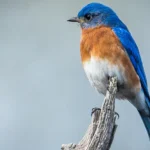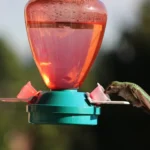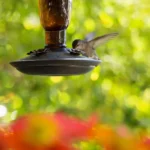Arizona’s Various scenery provides a natural variety of ducks, including the colorful Mallard and the distinctive Ruddy Duck. The state is home to 20 different species of ducks, each with its unique characteristics. Read more below.
List of 20 Ducks of Arizona:
1. Mallard:
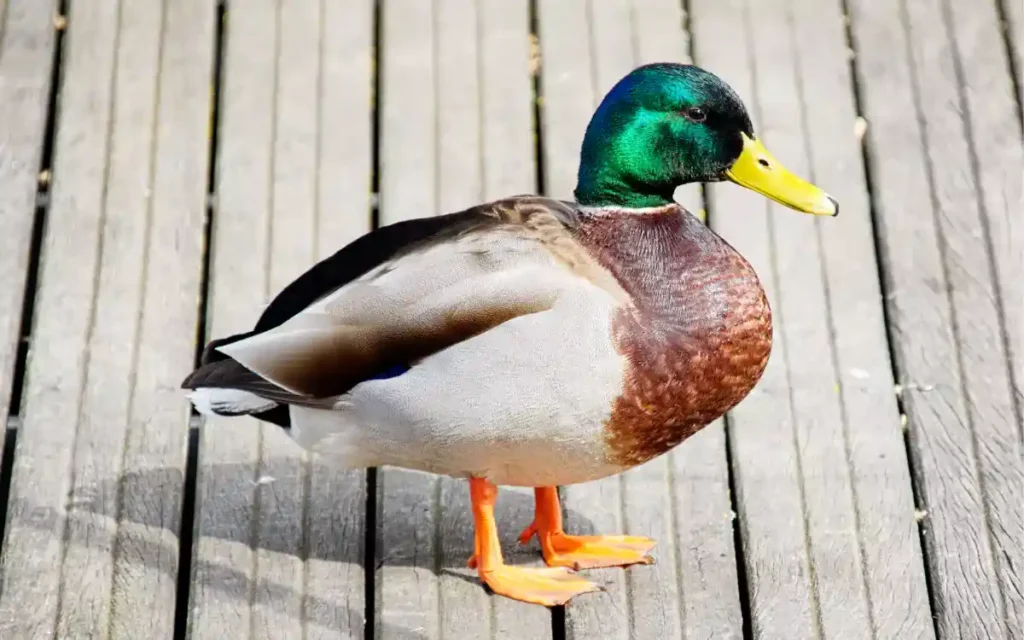
In Arizona, the Mallard duck is pretty special. It’s like the grandparent to many ducks we see at farms or in our backyards. These ducks are super good at living in different places, from wild lakes to city parks.
They have beautiful green heads (if they’re boys) and brownish bodies (for both boys and girls) which help them blend in.
What’s really cool is their ability to adapt, meaning they can handle living in lots of places, even where humans hang out. So, when you see a duck that looks kind of familiar, it’s likely a Mallard or one of its relatives.
They show us how animals can live alongside people and still keep being awesome.
- Length: 50 – 65 cm (20 – 26 in)
- Weight: 24 – 56 oz (0.7 – 1.6 kg)
- Wingspan: 32 – 39 in (81- 98 cm)
2.Northern Shoveler:

Northern Shovelers are unique-looking ducks with large, spoon-shaped bills. Males have bright green heads, white chests, and chestnut sides, while females are mottled brown.
They use their big bills to filter food from the water. These ducks are often found in marshes and shallow ponds. For more information, visit Audubon’s guide.
- Length: 17.3-20.1 in (44-51 cm)
- Weight: 14.1-28.9 oz (400-820 g)
- Wingspan: 27.2-33.1 in (69-84 cm)
3. American Wigeon:
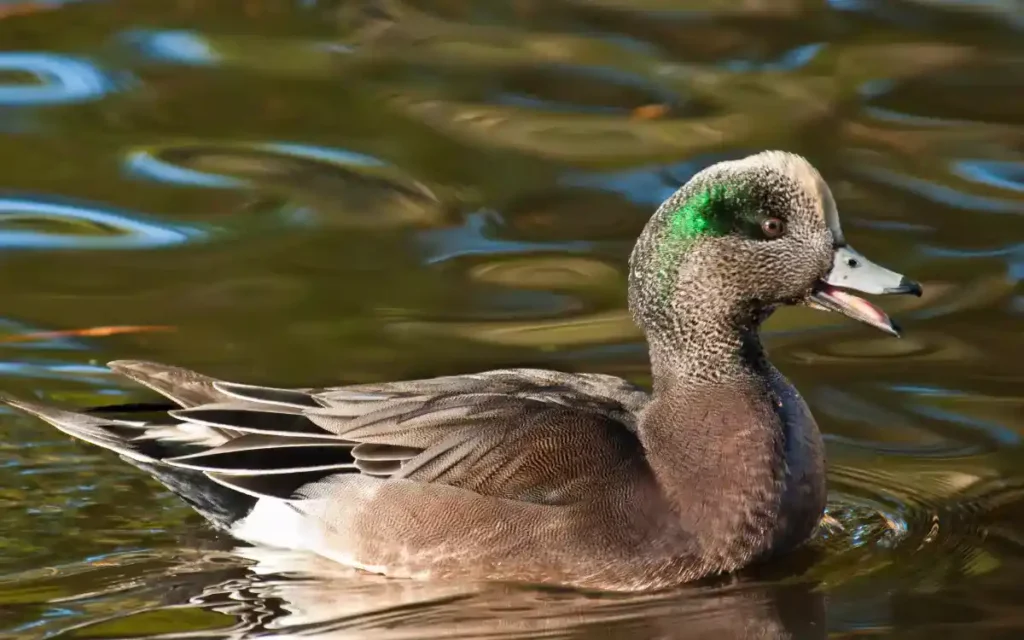
The American Wigeon is a duck with some cool habits. They’re known for their unique way of eating – they often “borrow” food from other ducks! Imagine going to dinner and eating off your friend’s plate; that’s what they do. These ducks are also great travelers.
Every year, they move from the cold north down to places like Arizona to enjoy the winter. This journey shows how smart and tough they are, traveling long distances to find the best spots to hang out and eat.
The American Wigeon’s clever feeding and migration patterns make them fascinating birds to learn about!
- Length:16.5 – 23.2 in (42 – 59 cm)
- Weight: 19.1 – 46.9 oz (540 – 1330 gm)
- Wingspan: 32 – 33.1 in (81 – 84 cm)
4. Cinnamon Teal:

The Cinnamon Teal is a duck that stands out because of its bright reddish-brown color. They love hanging out in shallow freshwater areas, like marshes and ponds. Sadly, they’re facing some tough times because their homes are disappearing.
This is because things like buildings and pollution changing their natural spaces. It’s important to take care of the places these ducks live so they can continue to brighten up our waters with their colorful presence. Their struggle reminds us why we need to protect our environment.
- Length: 15.1 – 16.9 in (38.4 – 42.8 cm)
- Weight: 11.8 – 14.1 oz (335 – 401 gm)
- Wingspan: 21.3 – 22.4 in (54 – 57 cm)
5. Green-winged Teal:
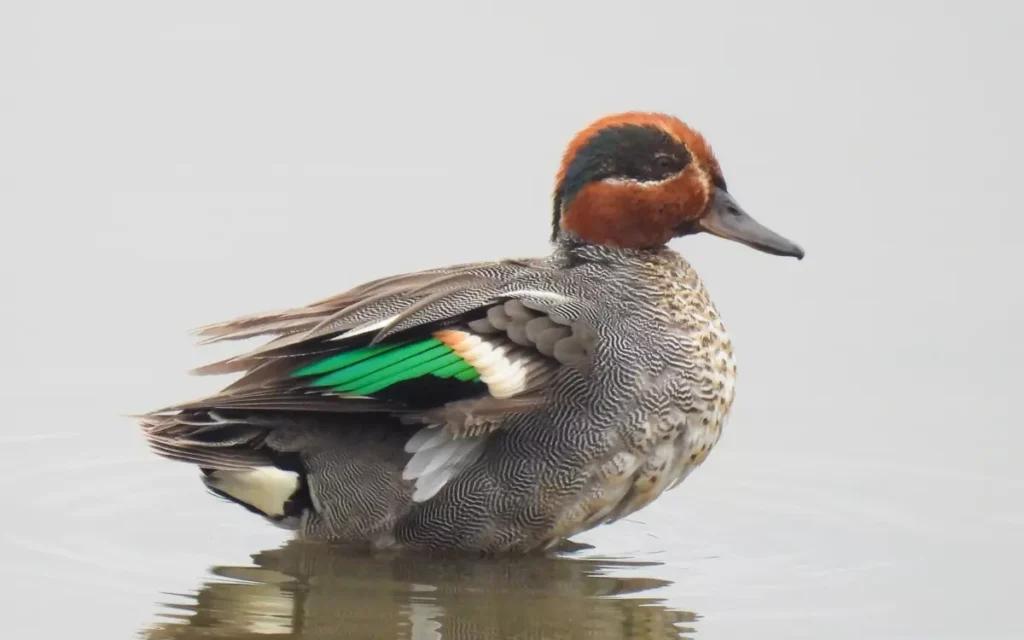
The Green-winged Teal is the tiniest duck around, but it’s got a big heart. These ducks prefer shallow waters like marshes where they can hang out and find their food easily. The best part? Their numbers are growing, meaning more and more of these little guys are out there.
This is awesome because it shows they’re doing well and finding plenty of places to call home. Their small size, love for marshy spots, and increasing population make them super cool ducks to learn about.
- Length: 12.2 – 15.3 in (31 – 39 cm)
- Weight: 4.9 – 17.6 oz (140 – 500 gm)
- Wingspan: 20.5 – 23.2 in (52 – 59 cm)
6. Black-bellied Whistling Duck:

The Black-bellied Whistling Duck is known for its unusual whistling call. These ducks have long legs, bright pink bills, and a black belly with a brown and white body. They are often found in warm,
tropical areas near freshwater ponds or lakes. Black-bellied Whistling Ducks are unique because they often perch in trees! Learn more about them on All About Birds.
- Length: 18.5-20.1 in (47-51 cm)
- Weight: 23.0-36.0 oz (652-1020 g)
- Wingspan: Approximately – 37 inches
Related article:
7. Lesser Scaup:

The Lesser Scaup is an amazing diver, always ready for a swim in open water. They’re pros at diving deep to find their favorite snacks, like bugs and plants. You’ll often see them in big lakes or coastal bays, where there’s plenty of room to dive and explore.
Their love for the water and their diving skills make them stand out. Watching a Lesser Scaup dive is pretty cool – they disappear under the water and pop back up like a little submarine!
- Length: 15.3 – 18.1 in (39 – 46 cm)
- Weight: 17.6 – 20.8 oz (500 – 600 gm)
- Wingspan: 24.4 – 24.8 in (62 – 63 cm)
8. Ring-necked Duck:

The Ring-necked Duck takes a cool trip to Arizona every winter. They’re easy to spot because of their unique markings. The boys have a bold black back and a white ring around their bill, while the girls are a stylish brown.
What’s special is they don’t have a ring around their neck, even though that’s their name! They love to hang out in lakes and ponds when they visit Arizona.
Watching them arrive is like seeing friends come back to town, and their distinctive looks make them stand out among winter guests.
- Length: 15.3 – 18.1 in (39 – 46 cm).
- Weight: 17.3 – 32.1 oz (490 – 910 gm)
- Wingspan: 24.4 – 24.8 in (62 – 63 cm)
9. Bufflehead:
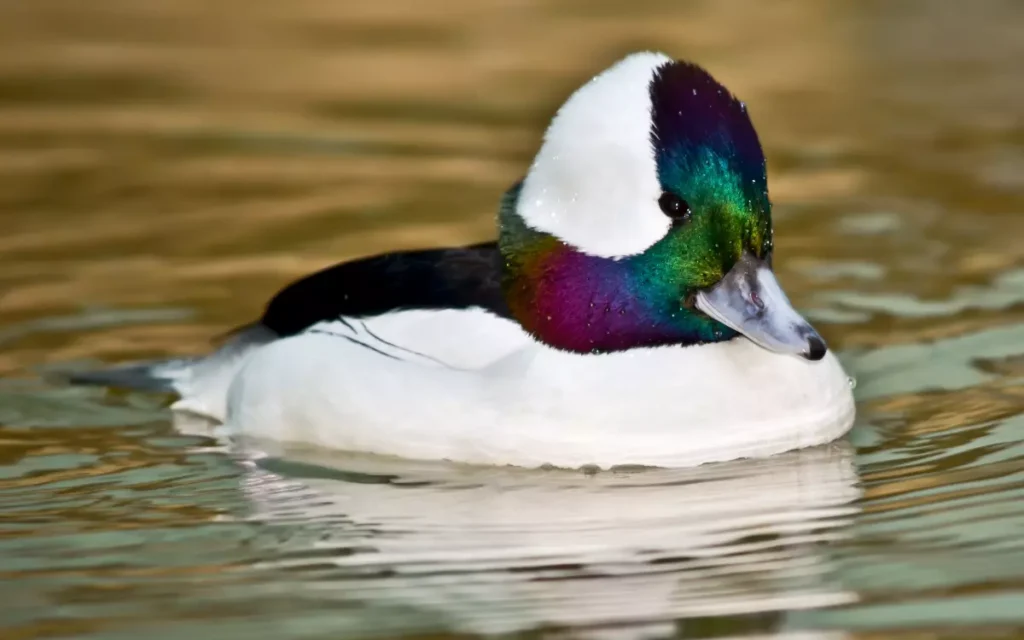
The Bufflehead is a small but mighty duck. They’re tiny and have amazing diving skills, darting underwater to snack on insects and plants. What really catches your eye is their colorful plumage.
The males have bold, white patches on their heads, making them stand out, while females are more subdued but still pretty. They love open water, like lakes and rivers, where they can dive freely. Watching a Bufflehead dive is like watching a little bullet shoot into the water – quick, sleek, and super cool!
- Length: 12.6 – 15.8 in (32 – 40 cm)
- Weight: 9.6 – 22.4 oz (272 – 635 gm)
- Wingspan: Approximately 21.6 in (55 cm)
10.Wood Duck:

The Wood Duck is one of the most beautiful North American ducks. Males have iridescent green and purple heads with ornate patterns, while females are brown with a white eye-ring.
Wood Ducks live in wooded swamps and marshes and are one of the few ducks that nest in trees. For more information, check out The Cornell Lab of Ornithology.
- Length: 18.5-21.3 in (47-54 cm)
- Weight: 16.0-30.4 oz (454-862 g)
- Wingspan: 26.0-28.7 in (66-73 cm)
11. Ruddy Duck:
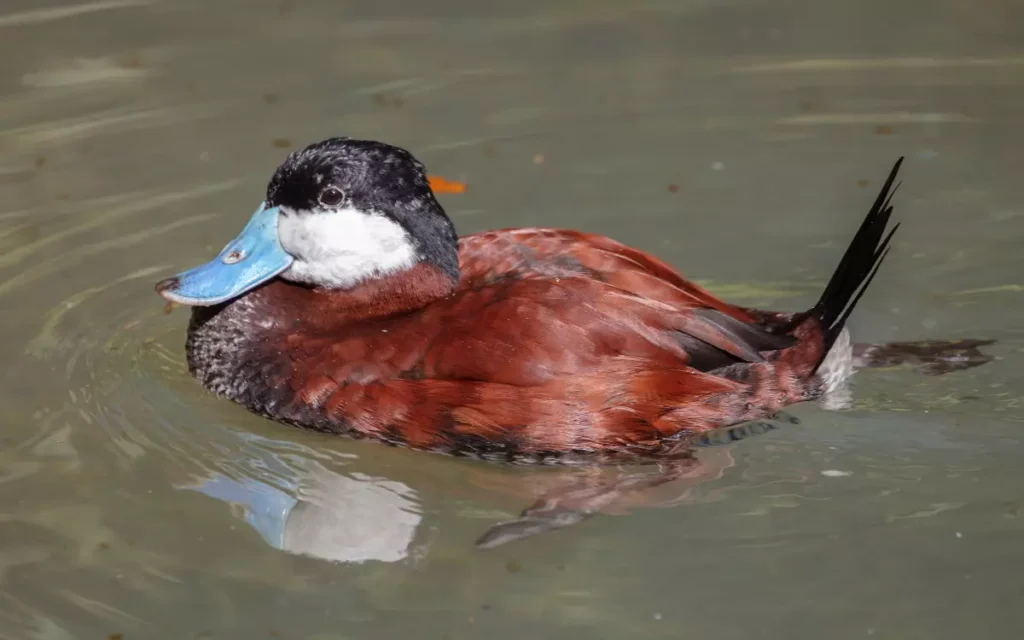
The Ruddy Duck is a small, colorful duck with a very cool trick. During the mating season, the boys puff out their chests and make their bright blue bill even brighter to impress the girls.
They also have a stiff tail that they stick straight up in the air while making bubbly sounds on the water.
It’s their way of saying, “Look at me!” This special dance happens in ponds and lakes, where they spend a lot of their time. Watching a Ruddy Duck show off is like seeing a little water dance – it’s fun and pretty unique!
- Length: 20.1 – 25.2 in(51 – 64 cm)
- Weight: 28.2 – 47.6 oz (800 – 1350 gm)
- Wingspan: 26.0 – 29.1 in (66 – 74 cm)
12. Mexican Duck:
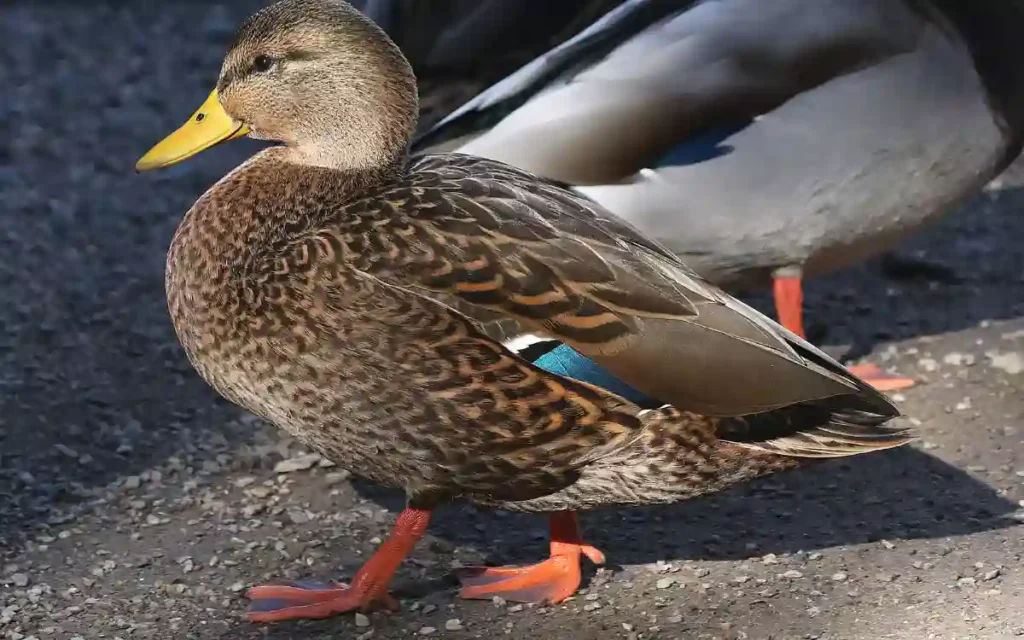
The Mexican Duck is similar to the Mallard but mainly found in Mexico and the southwestern United States. Males and females both have a mottled brown appearance.
They live in rivers, lakes, and marshes, feeding on plants and small animals. Learn more about Mexican Ducks on All About Birds.
- Length: 19.7 – 21.7 in (50 – 55 cm)
- Weight: 30.4 – 43.2 oz (849 – 1,243 gm)
- Wingspan: 32 – 37 in (81 – 94 cm)
13. Northern Pintail:
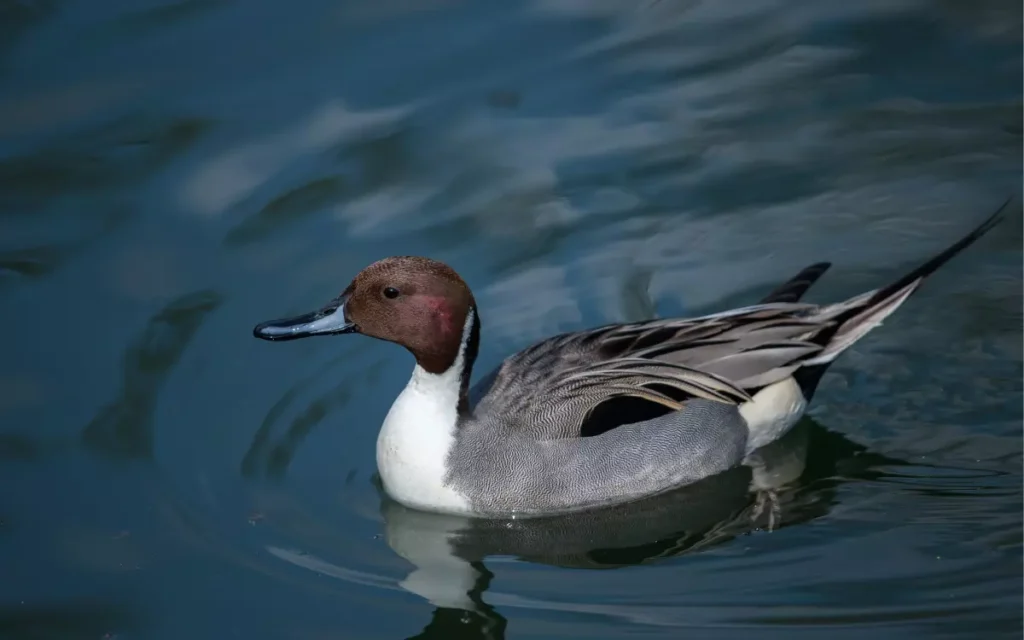
The Northern Pintail is a stunning duck that visits Arizona in the winter. With its long, sleek body and elegant neck, it’s easy to spot. The males have a striking look with a white breast, chocolate brown head, and a white stripe running down their neck.
Females are more subtle, dressed in brown but still graceful. They are not just about looks; these ducks are known for their incredible flying skills.
Every winter, they grace Arizona with their presence, adding beauty to the state’s wetlands and ponds.Their elegant appearance and seasonal visits make them a favorite among birdwatchers in Arizona.
- Length:18 – 30 in (45.7 – 76 cm)
- Weight: 16 – 48 oz (454 – 1362 gm)
- Wingspan: Approximately 35 in (89 cm)
Related article: 13 Owls In Arizona: North American Owl Species
14.Canvasback:
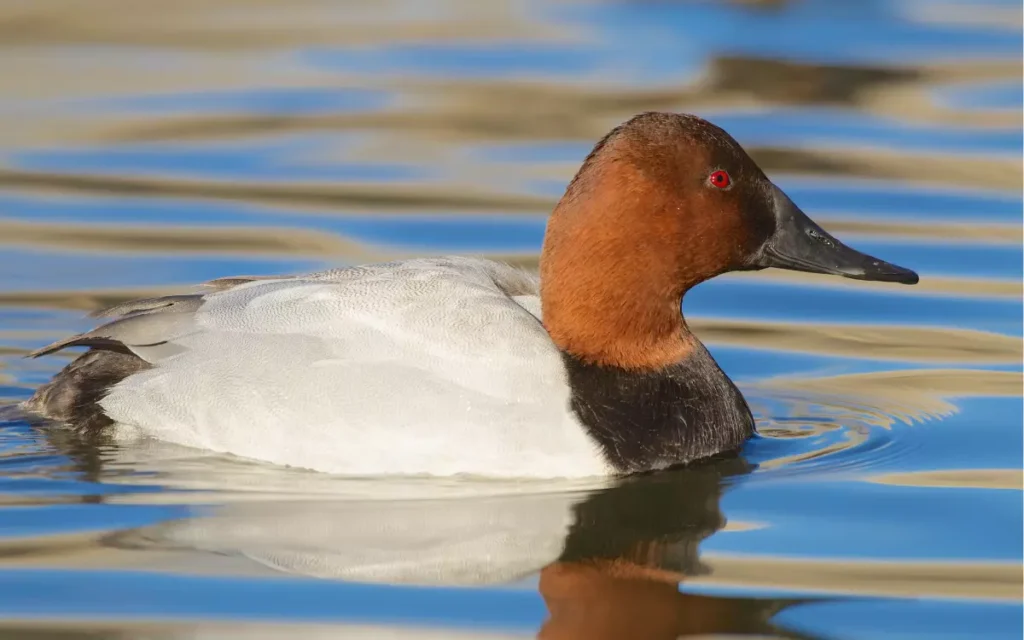
The Canvasback is a cool duck with a sleek look. They have a reddish head, black chest, and white back, making them pretty easy to spot. These ducks love big lakes and rivers, where the water is deep enough for them to dive for their food.
They’re like underwater hunters, looking for tasty plants to eat. Their love for deep water and their standout look, with that bold red head, make the Canvasback a fascinating bird to learn about and watch for.
- Length: 18.9 – 22.1 in (48 – 56 cm)
- Weight: 30.4 – 56.0 oz (862 – 1588 gm)
- Wingspan: 31.1 – 35.0 in (79 – 89 cm)
15.Common Merganser:
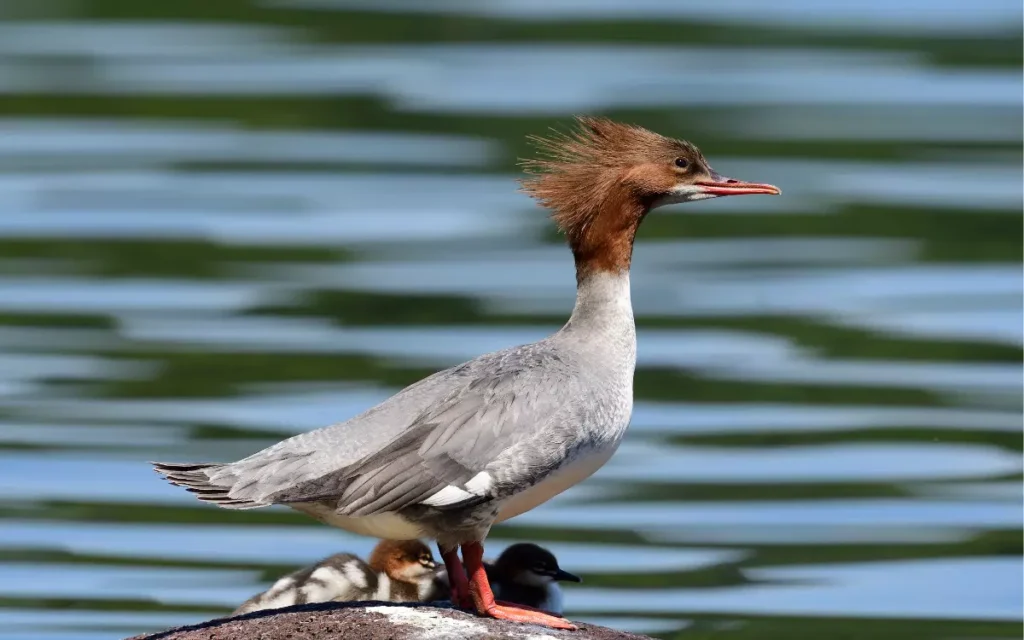
The Common Merganser is a big duck that loves to eat fish. They’re one of the largest ducks you might see, with sleek bodies and long, narrow bills perfect for catching fish.
These ducks spend a lot of time in rivers and lakes where fish are easy to find. They dive under the water and use their sharp bills to grab fish.
Common Mergansers are pretty amazing because they can catch and eat a lot of fish, making them super important for keeping fish populations in check. Their big size and fishy diet make them super cool ducks to learn about.
- Length: 25.5 in (65 cm)
- Weight: Males: 58.24 oz (1.65 kg), Females:43.68 oz (1.24 kg)
- Wingspan: 30.5 – 38 in (78 – 97 cm)
16. Common Goldeneye:

The Common Goldeneye is a duck that really stands out because of its bright yellow eyes. They love clear, fresh waters like lakes and rivers, where they can see well to find food. These ducks are great at diving, using their sharp eyes to spot fish and insects underwater.
The males have a shiny greenish-black head with a white body, making them look really cool. Females are gray with a chocolate brown head. Their love for clean, clear waters and those amazing eyes make the Common Goldeneye a fascinating bird to spot.
- Length: 15.8 – 20.1 in (40 – 51 cm)
- Weight: 21.2 – 45.9 oz (600 – 1300 gm)
- Wingspan: 30.3 – 32.7 in (77- 83 cm)
17. Hooded Merganser:

The Hooded Merganser is a cool duck with a special hat on its head. This hat can puff up or lay flat. They are awesome at diving down into the water to grab fish with their sharp eyes.
These ducks like clean places like ponds or rivers where there are lots of fish. Boys have a black and white hat, and girls have a brown one. Their fancy hats and diving tricks make them super interesting ducks to watch.
- Length: 15.8 – 19.3 in(40 – 49 cm)
- Weight: 16.0 – 31.0 oz (453 – 879 gm)
- Wingspan: 23.6 – 26.0 in (60 – 66 cm)
18. Red-breasted Merganser:

The Red-breasted Merganser is a super-fast flyer that lives by the sea. These ducks are amazing because they can fly quickly over the ocean, looking for fish to eat. They spend lots of time in salty waters, diving into the waves to catch their meals.
With sleek bodies and sharp bills, they’re built for speed, both in the air and underwater. Their life by the ocean makes them different from many other ducks, showing just how diverse duck habitats can be. Watching them zoom around their ocean home is really cool!
- Length: 20.1 – 25.2 in (51- 64 cm)
- Weight: 28.2 – 47.6 oz (800 – 1350 gm)
- Wingspan: 26.0 -29.1 in (66 – 74 cm)
19. White-winged Scoter:
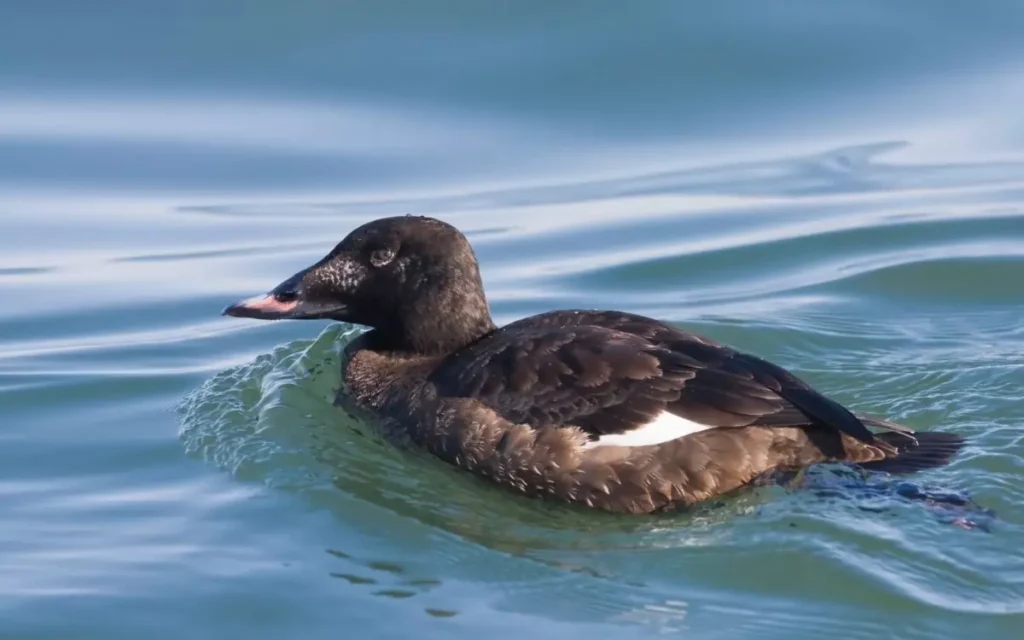
The White-winged Scoter is a large sea duck. Males are mostly black with white around the eyes and on the wings, while females are brown with a dark cap. They are typically found in coastal waters, often in large flocks. Learn more at All About Birds.
- Length: 18.9 – 22.8 in (48 – 58 cm)
- Weight: 33.5 – 63.5 oz (950 – 1800 g)
- Wingspan: 31.5 in (80 cm)
20. Blue-winged Teal:

The Blue-winged Teal is a small duck that loves to travel. They have a cool trick up their sleeve: they can fly long distances to spend the winter in warmer places, like Arizona. What makes them stand out are their bright blue wings and quick, agile flying.
The males have a neat white crescent on their faces, making them look quite dashing. These ducks are like the adventurers of the duck world, exploring far and wide but always looking stylish with their unique markings. Their journey and distinct looks make them super interesting ducks to get to know!
- Length:14.2 – 16.1 in (36 – 41 cm)
- Weight: 8.1 – 19.2 oz (230 – 545 gm)
- Wingspan: 22.1 – 24.4 in (56 – 62 cm)
Read more about – Arizona falcons
FAQs :
Q: What are some common duck species found in Arizona?
A: In Arizona, you can find species like the Mallard, Northern Pintail, Mexican Duck, and the Cinnamon Teal, among others.
Q: Can you see ducks year-round in Arizona?
A: Yes, some duck species like the Mallard and Mexican Duck can be seen year-round in Arizona, while others are seasonal visitors.
Q: Where is the best place to see ducks in Arizona?
A: Ducks can be observed in various wetlands, lakes, and rivers across Arizona. Popular spots include the Havasu National Wildlife Refuge and the Gilbert Water Ranch.
Q: Do ducks in Arizona migrate?
A: Many duck species in Arizona are migratory. For instance, the Northern Pintail and Cinnamon Teal migrate to Arizona during the winter months.
Q: What do ducks in Arizona typically eat?
A: Ducks in Arizona have varied diets that include aquatic plants, seeds, insects, and small fish.
Q: Are there any endangered duck species in Arizona?
A: While not necessarily endangered, some species like the Cinnamon Teal have habitats that are under threat, emphasizing the need for conservation efforts.
Q: How can I identify different duck species in Arizona?
A: Ducks can be identified by their size, color patterns, calls, and behavior. Field guides and birdwatching apps can be helpful tools for identification.
Q: Is it okay to feed ducks in Arizona’s parks and lakes?
A: It is generally discouraged to feed ducks in the wild, as it can lead to poor nutrition, overpopulation, and environmental issues.
Conclusion:
Arizona is home to a various array of ducks, including the Mallard and Ruddy Duck. These species contribute to the state’s rich birdwatching opportunities and play a crucial role in its ecological balance.




